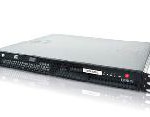Sixteen Eco-Friendly, Faster and ‚Cooler‘ Chips Incorporate 45nm Hafnium-Based High-k Metal Gate Transistors
Built using an entirely new transistor formula that alleviates the wasteful electricity leaks that threaten the pace of future computer innovation, Intel Corporation today unveiled 16 server and high-end PC processors. In addition to increasing computer performance and saving energy use, these processors also eliminate eco-unfriendly lead and, in 2008, halogen materials.
Called the biggest transistor advancements in 40 years by Intel Co-Founder Gordon Moore, the processors are the first to use Intel’s Hafnium-based high-k metal gate (Hi-k) formula for the hundreds of millions of transistors inside these processors. These Intel® Core™ 2 Extreme and Xeon® processors are also the first to be manufactured on the company’s 45-nanometer (nm) manufacturing process, further boosting performance and lowering power consumption.
Combining these two advancements with new processor features enables Intel to continue delivering faster and more energy-efficient processors that are better for the environment. The breakthroughs clear the path for Intel to design products that are 25 percent smaller than previous versions and, thus, more cost-effective, as well as the ability next year to pursue new ultra mobile and consumer electronics „system on chip“ opportunities.
„The intellects, physics and designs that went into solving one of the industry’s most daunting challenges are awe-inspiring and I congratulate the Intel teams for this breakthrough achievement,“ said Paul Otellini, Intel president and CEO. „Best yet, this feat, coupled with our industry-leading architectures, means faster and sleeker computers, longer battery life and better energy efficiency. Our objective is to bring consumers a new class of computers delivering a full Internet experience in ever-smaller, more portable form factors.“
The new 45nm (a nanometer is 1 billionth of a meter) processors boast nearly twice the transistor density of previous chips built on the company’s 65nm technology – that is up to 820 million transistors for quad-core processors, each using Intel’s new formula.
New High-End Desktop Processor
The Intel Core 2 Extreme QX9650 quad core processor, the world’s first 45nm Hi-k desktop processor, delivers more of the adrenaline that hardcore gamers and media enthusiasts demand. Enhancements such as a larger L2 cache and support for new Intel® SSE4 media instructions help bring desktop performance to „extreme“ new levels.
„One of our goals was to optimize Crysis in order to deliver the ultimate quality, bringing mind-blowing game play to the latest hardware,“ said Dr. Douglas Binks, R&D manager, Crytek. „With the new 45nm Hi-k Intel Core 2 Extreme processors, we use multi-core technology to enable physics, particle effects and audio on separate cores, helping Crysis to create an astounding gaming experience.“
Family of 45nm Server Processors; World-Record Speed
New to the Intel line-up of server processors are 15 server dual-core and quad-core 45nm Hi-k Intel Xeon processors. The 12 new quad-core chips boast clock speeds ranging from 2GHz up to 3.20GHz, with front side bus speeds (FSB) up to 1600MHz, and cache sizes of 12MB. The three new dual-core chips feature clock speeds of up to 3.40GHz, an FSB of up to 1600MHz, and cache sizes of 6MB.
The 45nm Hi-k Intel Xeon processors are compatible with server platforms using the Intel® 5000 chipset family. In addition, Intel is launching three platform solutions to support 45nm processors, including:
- The Intel® 5400 chipset-based platform (previously codenamed „Stoakley“) that is optimized for high-bandwidth applications such as high-performance computing (HPC).
- The Intel 5100 Memory Controller Hub chipset and Intel ICH-9R I/O controller (previously codenamed „Cranberry Lake“). These are cost-optimized solutions that support either one or two processors and also provide reduced power consumption using native DDR2 memory.
- The Intel 3200 chipset-based platform (previously codenamed „Garlow“) that is specifically designed for single-processor entry servers.
The 45nm Hi-k Quad-Core Intel Xeon processor 5400 series sets a number of world records** on key industry-standard benchmarks. A HP Proliant DL380 G5 Server sets a new TPC-C* mark with a score of 273,666 tpmC and an SAP-SD* record with a score of 2449 SD-Users. A Dell PowerEdge* 2950 server running BEA JRockit* JVM delivered a record-breaking SPECjbb*2005 result of 303130** BOPS. Dell also sets a new virtualization performance record on VMmark benchmark running VMWare ESX Server with a score of 8.47 at 6 tiles. Using a PRIMERGY RX300 S4 Server, Fujitsu-Siemens set a new SPECint*_rate2006 record with a score of 138.
Additionally, the 5400 series chipset-based platform with 1600 MHz Front Side Bus sets new world records** on key high-performance computing and bandwidth-intensive benchmarks including the SPECfp*_rate2006 benchmark that measures floating point throughput performance. World records were also achieved in key HPC benchmarks, including Fluent*, LS-Dyna*, SPECOMP2001* and Abaqus*. For detailed system and testing information on these and other performance benchmarks, visit www.intel.com/performance/server/xeon/summary.htm.
Intel’s 45nm Hi-k Xeon processors also extend performance-per-watt leadership by delivering an improvement of 38 percent1 over its previous-generation Quad-Core Xeon 5300 Series processors.
The move from 65nm to 45nm involves more than just a shrink of current chip designs. The processors include such additional features as new Intel® Streaming SIMD Extensions 4 (SSE4), which are 47 new instructions that speed up workloads including video encoding for high-definition and photo manipulation, as well as key HPC and enterprise applications. Software vendors supporting the new SSE4 instruction set include Adobe*, Microsoft* and Symantec*.
Additional processor performance enhancing architectural features include:
- Enhanced Intel® Virtualization Technology — Virtual machine transition (entry/exit) times are improved by an average of 25 to 75 percent through hardware with no changes to software required.
- Fast Division of Numbers – A fast divider roughly doubles the speed over previous generations for computations used in nearly all applications through a technique called Radix 16. The ability to divide instructions and commands faster increases a computer’s performance.
- Unique Super Shuffle Engine — By implementing a wider 128-bit shuffle unit, performance significantly improves for SSE-related instructions that have shuffle-like operations. This feature will increase performance for content creation, imaging, video and high-performance computing.
Pricing of the 45nm Hi-k Intel Xeon processors depends on the model, speeds, features and amount ordered, and ranges from $177 to $1,279 in quantities of 1,000. The 45nm Hi-k Intel Core 2 Extreme QX9650 quad core processor is priced at $999 in quantities of 1,000. Depending on the model, these processors are available today or within 45 days. Further information is available at www.intel.com/pressroom/kits/45nm.
About Intel
Intel, the world leader in silicon innovation, develops technologies, products and initiatives to continually advance how people work and live. Additional information about Intel is available at www.intel.com/pressroom and blogs.intel.com.
Intel, Intel Core and the Intel logo are trademarks of Intel Corporation in the United States and other countries.
* Other names and brands may be claimed as the property of others.
** World Record and other claims based on performance comparison of DP Server platforms based on x86 architecture. For more information, visit www.intel.com/performance/server/xeon/summary.htm. Intel does not control or audit the design or implementation of third-party benchmarks or Web sites referenced in this document. Intel encourages all of its customers to visit the referenced Web sites or others where similar performance benchmarks are reported and confirm whether the referenced benchmarks are accurate and reflect performance of systems available for purchase.
1 38 percent performance per watt improvement claim details based on SPECjbb*2005, for more information please visit www.intel.com/performance/server/xeon/summary.htm.




